#Telecom Generator
Explore tagged Tumblr posts
Text
Telecom Generator Market - Forecast(2024 - 2030)
Telecom Generator Market size is estimated to reach $3.1 billion by 2030, growing at a CAGR of 10.2% during the forecast period 2024–2030. The increasing demand for reliable and uninterrupted power supply for telecom equipment, such as antennas, switches, routers, servers and other network components are propelling the Telecom Generator Market growth.
Additionally, growing adoption of renewable energy sources is creating substantial growth opportunities for the Telecom Generator Market. These factors positively influence the Telecom Generator industry outlook during the forecast period.
COVID-19 / Ukraine Crisis — Impact Analysis:
● The COVID-19 pandemic significantly impacted the telecom generator market. A decline in economic activity led to reduced demand for telecom services, consequently decreasing the demand for telecom generators. Telecom generators are commonly utilized as backup power in telecom infrastructure, so this decline was exacerbated by the pandemic’s disruption of supply chains, which made it challenging for telecom operators to acquire generators. However, the telecom generator market is expected to recover in the long term, as the telecom industry is critical and there is a need for uninterrupted communication services. As the global economy rebounds, there will likely be an increased demand for telecom services, and consequently, a rise in demand for telecom generators as backup power sources.
● The conflict between Russia and Ukraine significantly impacted the telecom generator market, the telecom operators faced a surge in demand for generators, relying on them as backup power sources for telecom towers and infrastructure that had been damaged or disrupted. This increased demand resulted in price increases and shortages in the telecom generator market. Additionally, the Ukraine crisis had a broader impact on the global economy. The crisis caused economic uncertainty worldwide, making it more difficult for telecom operators to secure financing for their projects. As a result, the growth of the telecom generator market slowed down.
Key Takeaways:
● Fastest Growth Asia-Pacific Region
Geographically, in the global Telecom Generator Market share, Asia Pacific is analyzed to grow with the highest CAGR of 11.5% during the forecast period 2024–2030. The demand for mobile data and internet services in the Asia-Pacific region is experiencing a notable upswing, highlighting the need for dependable power supply to sustain telecom towers and base stations. With rapid urbanization, urban areas are witnessing a surge in demand for telecom services, underscoring the crucial role of telecom generators in ensuring uninterrupted power. The substantial investments by regional governments in infrastructure development present new opportunities for the telecom generator market. Moreover, telecom operators are increasingly acknowledging the significance of backup power, contributing to the growing demand for telecom generators.
● Gas to Register the Fastest Growth
In the Telecom Generator Market analysis, the Gas segment is estimated to grow with the highest CAGR during the forecast period. Telecom operators are increasingly focused on eco-friendly power solutions due to heightened environmental awareness. Gas generators are gaining favor over diesel generators for their superior environmental performance and cost-effectiveness. With the wide availability of natural gas as a reliable fuel source, it has become a preferred choice for telecom generators. Additionally, several governments are promoting gas generators as part of emission reduction regulations.
● Standby Load is Leading the Market
According to the Telecom Generator Market forecast, the Standby Load held the largest market share in 2022 owing to the growing the demand for uninterrupted power supply in the telecommunications industry, particularly in the standby load segment. Standby generators play a crucial role in providing backup power during power outages, ensuring the continuity of telecommunications services. The rising usage of mobile devices and data-intensive applications further amplifies the need for standby generators in the telecom sector.
● The Surging Demand for Reliable Telecom Power Supply for Telecom Equipment
Telecom operators and service providers recognize the importance of uninterrupted communication services and actively invest in reliable power solutions like telecom generators. The growing reliance on mobile devices, data-intensive applications and high-speed internet further contributes to the need for uninterrupted power supply. Technological advancements in telecom generators, improving efficiency and reducing emissions, fuel their adoption in the industry is escalating demand for reliable power significantly propels market growth as the telecommunications industry expands and technology advances.
● The Escalating Trend of Renewable Energy Sources Adoption
The market growth of telecom generators is fueled by the rising adoption of renewable energy sources like solar and wind power. Several factors contribute to this trend, including the increasing cost competitiveness of renewable energy, which appeals to telecom operators seeking to reduce operating expenses. Technological advancements such as battery storage and smart grids enhance the reliability of renewable energy, ensuring uninterrupted power supply. Furthermore, the environmentally friendly nature of renewables aligns with the sustainability objectives of telecom operators. As a result, the market for telecom generators utilizing renewable energy sources is anticipated to witness substantial growth in the future.
● High Costs of Generators Hamper the Market Growth
Increasing prices of raw materials like diesel and natural gas used to fuel generators and contribute to their un-affordability for many telecom operators, especially in developing countries. Consequently, operators are compelled to resort to less reliable backup power alternatives such as batteries or solar panels, compromising the network’s reliability and performance. Moreover, the substantial expenditure on generators reduces telecom operators’ profitability and hampers their capacity to invest in infrastructure upgrades or expansion. This cost barrier limits the adoption of vital backup power solutions, impeding market growth in the telecom industry.
Key Market Players:
Product/Service launches, approvals, patents and events, acquisitions, partnerships and collaborations are key strategies adopted by players in the Telecom Generator Market. The top 10 companies in this industry are listed below:
Caterpillar Inc. (Cat 3512C Generator Set, Cat 3512C Generator Set)
Kohler Co. (Kohler KDE75S-BT-EU, Kohler KDE75S-BT-US
Cummins Inc. (Cummins QSK60-ME, Cummins QSK95-ME)
Generac Holdings Inc. (Generac PWR-Pro 75S2E, Generac PWR-Pro 100S2E)
Briggs & Stratton Corporation(Briggs & Stratton 20000E Series, Briggs & Stratton 30000E Series)
Yanmar Co., Ltd. (Yanmar G125S-BT, Yanmar G250S-BT)
Doosan Corporation.(Doosan DL250SE-BT, Doosan DL350SE-BT)
Siemens Energy AG (SGen-100A/1000Agenerator series, SGen-2000P generator series)
Wärtsilä Corporation (16V46DF generator, 20V46DF generator)
Mitsubishi Heavy Industries, Ltd. (MU-G Series, MGS Series)
#Telecom Generator#Telecom Generator market#Telecom Generator forecast#Telecom Generator market analysis#Telecom Generator market shape#Telecom Generator market analysis#industry outlook
0 notes
Text
A British telecom company has made a generative AI bot that takes calls from scammers while impersonating a baffled old grandmother that tells meandering stories and goes on weird tangents to waste the scammers' time while also recording everything to get information on their operations.
This is, in a word, awesome.
66 notes
·
View notes
Text
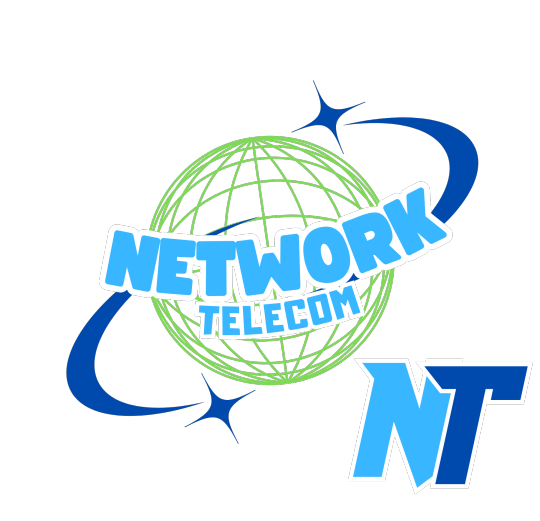
www.netrworkteleco.com
#network#telecom#ai generated#technology#tech#electronics#information technology#software#futurism#ai#news#world news#breaking news#trending
2 notes
·
View notes
Text
VodafoneThree - Physical Security Specialist
Job title: VodafoneThree – Physical Security Specialist Company: Vodafone Job description: a network the UK can count on – one that connects people, places and potential. Because no matter where you live…, that future’s being built – today. We’re creating more than the UK’s best network. We’re helping close the digital divide… Expected salary: Location: Bristol Area Job date: Thu, 19 Jun 2025…
#5G#5G Network Specialist#agritech#audio-dsp#Azure#cloud-native#CTO#data-engineering#data-privacy#deep-learning#DevOps#dotnet#edtech#erp#ethical AI#full-stack#game-dev#generative AI#it-consulting#it-support#Machine learning#mlops#NFT#Python#qa-testing#quantum computing#rpa#Salesforce#telecoms
0 notes
Text
Generative AI in Telecommunications: Driving Innovation and Operational Transformation
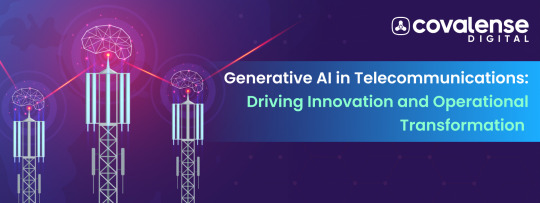
Generative AI in Telecommunications
As the telecom industry navigates rapid digital expansion, Generative AI emerges as an indispensable catalyst for operational agility and innovation. With soaring global data demands and the rise of complex service ecosystems, traditional methods fall short in addressing the modern requirements for speed, scale, and intelligence. By empowering telecommunications providers to analyse data flows, anticipate trends, and automate workflows, Generative AI lays the groundwork for precision-driven strategies that are essential for competitiveness. It bridges the gap between rising customer expectations and complex operational demands, offering AI-driven solutions that ensure precision and efficiency across marketing, customer engagement, and workflows. Understanding its role is key to staying ahead in a sector marked by constant evolution and complexity.
Generative AI-Powered Telecom Solutions for Enhanced Efficiency
Telecommunications providers are increasingly turning to Generative AI-driven solutions to optimise their operations and stay competitive in a fast-changing industry. These advanced tools help streamline customer engagement, enhance marketing efforts, and improve internal workflows. By leveraging machine learning and real-time data, telecommunications companies can make smarter decisions and respond more effectively to customer needs. With seamless integration into existing systems, these Generative AI solutions offer scalability, efficiency, and agility in a market where technology is constantly evolving.
AI-Driven Marketing Campaigns
Generative AI enables telecommunications marketing teams to create data-driven, precision-targeted campaigns. By analysing behavioural data, spending trends, and engagement patterns, AI-powered systems segment customers based on preferences and usage. Advanced algorithms craft customised campaigns aligned with individual needs, driving higher conversions and engagement. For instance, AI identifies customers frequently upgrading plans and suggests personalised offers, such as loyalty rewards or premium service discounts, delivered through preferred channels like SMS or email. Real-time insights optimise campaign timing. With multi-channel delivery, proactive insights, and visual analysis, campaigns adapt dynamically based on customer responses. Automated workflows streamline execution, ensuring impactful, cost-effective marketing strategies that boost customer satisfaction and revenue.
Next Best Reward Optimisation
Telecommunications loyalty programmes are advanced through machine learning (ML) and IoT analytics for precision-driven reward strategies. ML algorithms analyse real-time data, spending patterns, and service usage to identify high-value customers, ensuring rewards are customised to individual preferences. For example, AI can identify customers who frequently upgrade their plans and offer personalised incentives such as premium data packages or discounts on 5G upgrades. AI detects data overages and recommends proactive offers, boosting customer satisfaction and Net Promoter Scores (NPS). IoT-driven insights enable proactive solutions, such as offering family plans to high-demand users. Seamlessly integrated billing systems automate reward delivery, ensuring operational efficiency. Predictive analytics continuously refine strategies, aligning rewards with business objectives to maximise customer engagement and profitability.
Enhanced Customer Connections through Generative AI Solutions
Generative AI empowers telecom providers to deliver personalised, proactive experiences by analysing real-time data using advanced algorithms, behavioural analytics, and machine learning models. AI generates customised value propositions, such as optimised data plans for frequent streaming users, ensuring precision and relevance. Proactive insights predict customer needs, enabling timely recommendations like data top-ups or package upgrades through automated notifications. Cloud-powered scalability ensures seamless delivery of personalised engagements, adapting dynamically to surges during high-demand events. Natural language processing (NLP) refines customer interactions, interpreting sentiments from chat or voice data. This approach builds trust, drives upselling opportunities, and creates loyalty with offers like early 5G access or premium support, ensuring operational excellence.
Advanced Data Insights for Operational Excellence
Telecommunications providers are equipped with actionable insights to enhance internal workflows and strategic decision-making. Using advanced machine learning models, AI analyses structured and unstructured data to identify patterns that optimise resource allocation, workforce efficiency, and cost management. For instance, AI predicts network traffic spikes, enabling proactive capacity adjustments during peak periods. By uncovering operational inefficiencies, such as underutilised assets, the system suggests corrective measures to reduce costs. Dynamic dashboards provide real-time data visualisation, facilitating leadership decisions on market trends and bottlenecks. With cloud-powered scalability, these insights are delivered efficiently, aligning strategies with business goals to maximise profitability and competitiveness.
Intelligent Case Management
Our solution integrates AI-powered Intelligent Case Management systems that improve real-time query processing through NLP and machine learning. These systems categorise and prioritise cases, enabling immediate escalation of issues like network outages based on customer sentiment and SLA parameters. When a customer reports a recurring billing issue, the system analyses historical interactions, categorises the query, and assigns it to an agent with expertise in billing discrepancies, offering recommended solutions. Comprehensive dashboards analyse trends, optimise workflows, and expedite root cause identification via pre-built API integrations, ensuring minimal downtime, peak scalability, and adaptive resolutions.
Transforming Telecommunications with Generative AI and Csmart
Generative AI is set to reshape telecommunications by enabling more precise decision-making, automating complex workflows, optimising network resource management, and analysing IoT data for actionable insights. These developments are key to improving operational efficiency, scaling operations, and uncovering new market potential.
Csmart's cutting-edge Generative AI solutions combine advanced algorithms with deep industry expertise to revolutionise telecommunications operations. Our integrated approach helps operators navigate complex challenges while driving operational excellence, enhancing customer experiences, and unlocking new growth opportunities. Through seamless technology integration and innovative AI capabilities, we empower telecommunications providers to stay ahead in an evolving digital landscape.
Ready to transform your telecommunications operations? Contact us at [email protected] to explore how our Generative AI soultions can drive innovation and efficiency in your organisation.
To know more visit: Covalensedigital LinkedIn
Follow on: Covalensedigital Twitter
0 notes
Text
Airtel started using AI tools to identify spam calls, Will it help!
Bharti Airtel, India’s second-largest phone company, announced that it will start using an AI tool to help identify and block spam calls and messages for all its customers.The company claims the solution is India’s first network-based, AI-powered, spam detection system.The feature will alert Airtel’s customers in real-time to suspected spam calls and text messages, and will automatically activate…
#airtel#ai generated#artificial intelligence#telecom#news#science#tech#technology#telegram#tekginger#TekGinger
0 notes
Text
The Generative AI Revolution: Transforming Industries with Brillio
The realm of artificial intelligence is experiencing a paradigm shift with the emergence of generative AI. Unlike traditional AI models focused on analyzing existing data, generative AI takes a leap forward by creating entirely new content. The generative ai technology unlocks a future brimming with possibilities across diverse industries. Let's read about the transformative power of generative AI in various sectors:
1. Healthcare Industry:
AI for Network Optimization: Generative AI can optimize healthcare networks by predicting patient flow, resource allocation, etc. This translates to streamlined operations, improved efficiency, and potentially reduced wait times.
Generative AI for Life Sciences & Pharma: Imagine accelerating drug discovery by generating new molecule structures with desired properties. Generative AI can analyze vast datasets to identify potential drug candidates, saving valuable time and resources in the pharmaceutical research and development process.
Patient Experience Redefined: Generative AI can personalize patient communication and education. Imagine chatbots that provide tailored guidance based on a patient's medical history or generate realistic simulations for medical training.
Future of AI in Healthcare: Generative AI has the potential to revolutionize disease diagnosis and treatment plans by creating synthetic patient data for anonymized medical research and personalized drug development based on individual genetic profiles.
2. Retail Industry:
Advanced Analytics with Generative AI: Retailers can leverage generative AI to analyze customer behavior and predict future trends. This allows for targeted marketing campaigns, optimized product placement based on customer preferences, and even the generation of personalized product recommendations.
AI Retail Merchandising: Imagine creating a virtual storefront that dynamically adjusts based on customer demographics and real-time buying patterns. Generative AI can optimize product assortments, recommend complementary items, and predict optimal pricing strategies.
Demystifying Customer Experience: Generative AI can analyze customer feedback and social media data to identify emerging trends and potential areas of improvement in the customer journey. This empowers retailers to take proactive steps to enhance customer satisfaction and loyalty.

3. Finance Industry:
Generative AI in Banking: Generative AI can streamline loan application processes by automatically generating personalized loan offers and risk assessments. This reduces processing time and improves customer service efficiency.
4. Technology Industry:
Generative AI for Software Testing: Imagine automating the creation of large-scale test datasets for various software functionalities. Generative AI can expedite the testing process, identify potential vulnerabilities more effectively, and contribute to faster software releases.
Generative AI for Hi-Tech: This technology can accelerate innovation in various high-tech fields by creating novel designs for microchips, materials, or even generating code snippets to enhance existing software functionalities.
Generative AI for Telecom: Generative AI can optimize network performance by predicting potential obstruction and generating data patterns to simulate network traffic scenarios. This allows telecom companies to proactively maintain and improve network efficiency.
5. Generative AI Beyond Industries:
GenAI Powered Search Engine: Imagine a search engine that understands context and intent, generating relevant and personalized results tailored to your specific needs. This eliminates the need to sift through mountains of irrelevant information, enhancing the overall search experience.
Product Engineering with Generative AI: Design teams can leverage generative AI to create new product prototypes, explore innovative design possibilities, and accelerate the product development cycle.
Machine Learning with Generative AI: Generative AI can be used to create synthetic training data for machine learning models, leading to improved accuracy and enhanced efficiency.
Global Data Studio with Generative AI: Imagine generating realistic and anonymized datasets for data analysis purposes. This empowers researchers, businesses, and organizations to unlock insights from data while preserving privacy.
6. Learning & Development with Generative AI:
L&D Shares with Generative AI: This technology can create realistic simulations and personalized training modules tailored to individual learning styles and skill gaps. Generative AI can personalize the learning experience, fostering deeper engagement and knowledge retention.
HFS Generative AI: Generative AI can be used to personalize learning experiences for employees in the human resources and financial services sector. This technology can create tailored training programs for onboarding, compliance training, and skill development.
7. Generative AI for AIOps:
AIOps (Artificial Intelligence for IT Operations) utilizes AI to automate and optimize IT infrastructure management. Generative AI can further enhance this process by predicting potential IT issues before they occur, generating synthetic data for simulating scenarios, and optimizing remediation strategies.
Conclusion:
The potential of generative AI is vast, with its applications continuously expanding across industries. As research and development progress, we can expect even more groundbreaking advancements that will reshape the way we live, work, and interact with technology.
Reference- https://articlescad.com/the-generative-ai-revolution-transforming-industries-with-brillio-231268.html
#google generative ai services#ai for network optimization#generative ai for life sciences#generative ai in pharma#generative ai in banking#generative ai in software testing#ai technology in healthcare#future of ai in healthcare#advanced analytics in retail#ai retail merchandising#generative ai for telecom#generative ai for hi-tech#generative ai for retail#learn demystifying customer experience#generative ai for healthcare#product engineering services with Genai#accelerate application modernization#patient experience with generative ai#genai powered search engine#machine learning solution with ai#global data studio with gen ai#l&d shares with gen ai technology#hfs generative ai#generative ai for aiops
0 notes
Text
7 Ways to Promote Responsible Use of Generative AI
Responsible Use of Generative AI Introduction As the field of artificial intelligence continues to evolve, one aspect that has garnered significant attention is generative AI. This technology, often referred to as deep learning or neural networks, has the ability to create new and original content based on patterns and data it has been trained on. While the applications of generative AI are…

View On WordPress
#responsible use of generative ai?#use of generative ai#what is the use of generative ai in telecom domain#what is use of generative ai in telecom domain#which of the following is a potential use of generative ai#which of the following statement is correct about the responsible use of generative ai#which of the following statements is correct about the responsible use of generative ai?
1 note
·
View note
Text
Crowley was rather proud of the Employee Hellpline. There had been a contest, about twenty years back, to create the most confusing phone structure possible, and Crowley had won. (He'd got inspired by calling up a telecom company to cancel service. Despite the fact that he'd made the call without an account, he'd left having agreed to a phone/television/Internet bundle and two magazine subscriptions.)
What he’d forgotten was the fact that he was an Employee, and thus had to navigate the labyrinthine obscurity of the Hellpline every time he needed to put in a request for a little extra power or office supplies. Fortunately, he didn't tend to make many calls; unfortunately, this meant that any insight he gained into the pattern had generally evaporated by the next time he had to face it.
Which was how he came to be sitting in his car, twenty minutes late for lunch, being informed in a monotone that he’d better listen carefully to the following menu, as options might have changed.
“For complaints about colleagues, press 1. For complaints colleagues made about you, press 2. For accounts payable, press 3, then 8, then turn the phone around and repeat. For accounts receivable, enter your ID in reverse. For all other financial requests, spell the first 10 pages of the Bee Movie script using your keypad. For—”
There was a knock at the window. “Are you quite all right?” Aziraphale said.
Crowley rolled the window down, half-listening to the phone menu. “Sorry I’m late—”
“You weren’t late. You drove up twenty-five minutes ago and took the ‘Reserved for Customers of AZ Fell & Co’ spot. So no actual customers have been able to park here this entire time. Which is dreadful,” Aziraphale added happily.
“This concludes the menu. Make your selection in the next four seconds or this call will be terminated. Four…three…” Crowley racked his brains attempting to remember whether accounts payable was 8, then 3, or— “Good-bye,” the voice said, with gloomy satisfaction, and hung up.
“Ahhh, sanctify it.”
“What?”
“I’m trying to get this reimbursement through. I had to buy eighty live bats for this work thing, and apparently that kind of order can’t go through the normal process. So I’m on the Hellpline. But this consecrated phone—”
“Didn’t you design the system?”
“Might’ve done.”
“May I?”
Crowley hit Redial and placed the phone in Aziraphale’s outstretched hand.
Aziraphale listened thoughtfully to the first list of menu options, then tapped the phone. He listened a bit longer, tapped twice more, said, “Mammal, not otherwise specified,” and handed it back.
A voice crackled in Crowley's ear. “Accounts payable, living creatures from twoscore to nine dozen. How can I hinder you today?”
“One sec,” Crowley said, and moved the phone away. “How’d you do that?”
“It was yours, wasn’t it?”
“Yeah.”
“I suppose I simply know how to thwart you,” said Aziraphale smugly. “Go on,” he said, nodding at the phone as he got in the car. “We’re late.”
1K notes
·
View notes
Text
In 2017, watching a two-hour Bastille Day procession, Donald Trump told the French president that we’d have one too, only better. That time, the grown-ups said no. The reasons given were costs – estimates ran to $92m – hellish logistics, and the Washington DC mayor Muriel Bowser’s worries that tanks and other armored vehicles would tear up Washington’s streets.
Some retired generals objected publicly to the totalitarian-adjacent optics, especially given the US president’s praise for such bad actors as Saddam Hussein and Vladimir Putin. Several Republican lawmakers also expressed their distaste. “Confidence is silent, and insecurity is loud,” the Louisiana senator John Kennedy told MSNBC. “America is the most powerful country in all of human history ... and we don’t need to show it off. We’re not North Korea. We’re not Russia, we’re not China,” he continued, “and I don’t wanna be.”
This time, as Washington prepares for a huge military shindig on 14 June, Trump’s 79th – and, oh yes, the US army’s 250th – birthday, the generals are silent. The Republicans have sworn allegiance to the king. And the media are focused on the price tag, the potholes and the impending pomp; on tensions between the blue city of Washington and the red capital; and on the decimation of veterans’ healthcare, housing, and pensions while the administration throws $25m to $45m at a circus of war.
All are important parts of the story. Yet commentary is muted and the debate mischaracterized as normal political discourse. The horrific point is missed: the spectacle of a massive show of military might, before a president who behaves like a dictator and views the armed forces as his personal foot soldiers, evinces memories of the worst totalitarian regimes. History may mark 14 June 2025 as the ceremonial birth of a new American fascism.
Military Parade in Capital on Trump’s Birthday Could Cost $45 Million, Officials Say, reported the New York Times in mid-May. CBS also led with the cost. The Washingtonian described in detail the street-damage-preventive measures the army is installing: metal plates under the parade route, rubber padding on the tank treads – though transportation experts warn that running, at last count, 28 Abrams tanks, 28 Bradley fighting vehicles, 28 Strykers, and four Paladins, each behemoth weighing as much as 70 tonnes, could buckle the asphalt and smash power, water and telecom lines underneath.
Even the New Republic, the president’s daily disparager, put the cost up top, tallied the ordinance, and noted that the man who “signed an executive order creating a program to ‘beautify Washington DC’” was now “plotting to transform his expensive birthday party into a demolition derby that will cause serious damage to the roads that line the nation’s capital”.
140 notes
·
View notes
Text
Ranking 2024 anime, Pt. 5: #10-1
hey, this post is also available on my ko-fi, so please check it out and consider tipping/donating as i do this for free and am currently between jobs. you can find part 1 of the list here, part 2 here, part 3 here, and part 4 here. all of my seasonal reviews are on my ko-fi and under my anime reviews tag, mixed in with my occasional musings. thanks!
And we are in the home stretch! I didn't want to split up my top 10 like last year, so it took a couple days to get it all together. Thanks for your patience.
As you may have noticed, some of these reviews are longer than others. I've reviewed most of these shows before, so I didn't want to be too redundant while talking about shows I've already reviewed. You can, of course, go back and read my initial reviews in my previous seasonal roundups.
Also, I just wanted to quickly shout out a few shows that I haven't watched much or any of, but would likely have placed well in these rankings, namely Dead Dead Demon's Dededede Destruction, YATAGARASU, the Spice and Wolf remake, Orb: On the Movements of Earth, Sound! Euphonium's third season, and the late Akira Toriyama's SAND LAND and Dragon Ball DAIMA. I only have so much time in a day, week, month, and year, but those series have been on my radar and I do intend to pick them up sooner or later.
But for now, let's focus on what I did watch. Off we go:
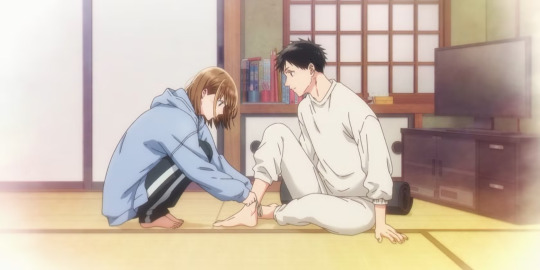
10. Blue Box
This is a slightly biased placement on my end because I picked up the manga this year and quickly fell in love with it, and I’m just happy that it got a faithful, well-made anime adaptation. If you have an issue with that, I’m gonna let you in on a little secret: This whole list is biased. It’s MY list, after all.
After the lovely-looking but uneven Astro Note, Telecom Animation Film is in full form adapting Kouji Miura’s gorgeous high school sports romance. Rising first-year badminton player Taiki has a huge crush on his basketball star senpai Chinatsu, who practices in the same high school gym he does. He’s happy enough to keep a friendly distance as they improve at their respective sports, but that distance is closed significantly when her parents go abroad for work and she ends up moving in under the same roof as him. The spirit of competition is in the air, and is that a whiff of romance I smell as well?
The reason I felt the need to call out my own bias at the start is because Blue Box’s debut cour is, on balance, probably just “pretty good,” but I was just so overjoyed that this anime even exists that I was willing to overlook the early story’s growing pains. Taiki, of course, is the POV character for most of the first cour, and most of the romantic tension we see so far is entirely from his end as he swoons and huffs and goes into cardiac arrest over any and every gesture Chinatsu throws his way. You know, teenage boy stuff. There have been criticisms that Chinatsu doesn’t get much interiority for a bit and that she’s a bit of an enigma in terms of her role in the central “romance,” such that it is so far, which is a valid criticism of a lot of shonen romance stories. I’m generally of the mind that these things are more potent when the object of the protagonist’s affection is treated as more than a puzzle for him to solve, but I think Blue Box does a fine job of establishing what Chinatsu means to Taiki before we do indeed begin to get a feel for how she operates and what she might think of him. If you found that part a little maddening early on, trust me when I say it’s worth sticking it out.
Regardless, the character writing is what made Blue Box such a hit in Weekly Shonen Jump. Taiki is a flat-out good kid, if a little naive, and his boundless determination to achieve and exceed his goals in both badminton and romance makes him easy to root for. Chinatsu is fairly taciturn, as mentioned, but that’s by design; she’s a notoriously difficult person to read, as even her friends and teammates note that they can rarely decipher what she’s thinking. She’s still an effortlessly charming character, and it’s not hard to figure out why Taiki’s got it so bad for her. The real highlight of the series, though, is Taiki’s classmate and longtime friend, Hina, a rhythmic gymnast and an absolute troll. She is an absolute delight in every scene she’s in, whether she’s knocking Taiki’s knees out from under him, focusing on rehearsing her next routine, or prying into Taiki’s love life and realizing that, oops, she really cares about him too. Hina is wonderful and I just want the best for her.
Characters this likable will need the voices to match, and I am over the moon about this show’s casting. Shouya Chiba is tremendous as Taiki, in a far cry from his Epic Based Stoic Chad role as Ayanokoji in Classroom of the Elite. Every line read for Taiki sounds exactly as gung-ho about sports and devastatingly down bad for his crush as you’d expect of a hormonal 15 year old. Reina Ueda is terrific as the soft-spoken Chinatsu, but I’m looking forward to hearing the always-delightful Xanthe Huynh (Haru in Persona 5, Marianne in Fire Emblem Three Houses) take on the role in the dub just as much. Akari Kitou channels much of the same gremlin energy she did for KamiKatsu to portray Hina’s mischief, and I look forward to hearing her nail Hina’s excellent upcoming character moments. And although it’s a secondary role, the casting I was most excited to hear was Chiaki Kobayashi (Mash in Mashle, Stark in Frieren) as Taiki’s teammate Kyo. Kobayashi’s languid tsukkomi affect was exactly what I had in mind whenever Kyo would put Taiki’s lovelorn antics into stark relief in the manga. It’s like he was born for the part.
This show looks tremendous, perfectly adapting both the angular, doe-eyed character designs from the manga as well as the lower-detail gags. The pastel color palette and gorgeous lighting effects are exactly what I was hoping for while reading the manga. If I have any complaint, though, it’s mostly that I want to see more of the sports action. The granular details of the badminton matches and basketball games are hardly the focus of the story, but the action panels are usually the best part of Miura’s art in the manga. Shot-for-shot, it certainly does hew close to the manga presentation, but it’s mostly a racquet swing or close-up jump shot followed by an onlooker’s reaction. I’d have liked a bit more follow through. The CGI used for background competitors can get a little distracting after a while, too, but it’s easy to forget about.
Blue Box is continuing into 2025, and I’m waiting for every new episode with bated breath. If you liked the first cour enough but still have doubts, trust me when I say it just keeps getting better. I look forward to coming back to the second half of this season in another year for my victory lap.

9. Girls Band Cry
This is one of the most inventive girls-band anime out there, certainly the most so since that one from 2022 that I swore I wouldn’t bring up by name. Gorgeous 3D-CG animation, stirring original music, and a compelling cast of characters combine to make Girls Band Cry even more than the sum of its parts.
More than anything, I think what makes Girls Band Cry a terrific showbiz series is that it depicts the uncomfortable reality that a lot of artists are just flat-out unpleasant people and often don’t mesh well with one another. Protagonist Nina is messy, stubborn, and angry at the world and her parents and will not hesitate to make it your problem. She butts heads with her friends and bandmates at any provocation, but stubbornness is a major driving factor in the plot: Each of the five members of Togenashi Togeari has something they’re trying to move on from with their music, and while they each have an opinion on how to get there, they do come to realize, after a lot of silly yelling matches, that they want to do so together.
As a vehicle to push Girls Band Cry and Togenashi Togeari as a real-world multimedia experience, this show is a success. It’s a terrific-looking show in ways we rarely see outside of Studio Orange productions (and allegedly Love Live! Sunshine!!, which director Kazuo Sakai also had a hand in); the 3D computer-generated character models and animations are terrifically expressive and lively, and creative visual effects add a compelling sense of synaesthesia to Nina's emotional highs and lows. The voice cast, all pseudonymous contest winners, are also the real-life band members, and they fully nail both elements of their roles. TogeToge’s music in the show is terrific, and as an already-existing Gorillaz-esque virtual band, I’m excited to dig into their back catalog.
Girls Band Cry finally got an official English translation, so there’s no longer any excuse to sleep on this one. It’s funny, it’s heartfelt, and above all else, it fucking rocks. Don’t let this one fade away just because you might’ve missed it when it aired.

8. Frieren: Beyond Journey’s End, second cour
When I ranked the first cour of Frieren as the best anime of 2023, I wrote:
The debut season of Frieren will continue into 2024, and if the quality remains a constant, it could very well be one of the best anime of next year too. It has remained as MyAnimeList’s top-rated anime ever for its entire run, warding off the legion of Fullmetal Alchemist Brotherhood fans. Frieren deserves it.
A year later, it is still MAL’s top-rated anime, and by a healthy margin. Another 12 episodes aired to kick off 2024, and it was indeed one of the best anime of this year as well. I stand firm in my convictions that not only is it one of the best anime of the decade so far, it’s one of the best anime I’ve ever seen.
I really shot my wad by praising Frieren so profusely midway through its run, to the point where I still don’t really feel the need to add much more here. The second cour mostly focuses on the First Class Mage exam arc, allowing us to learn more about the present state of magic in the modern day and adding some much-needed depth to the cast. It continues to strike a lovely balance between the quieter moments and bonkers action sequences, as well as the more serious moments with laugh-out-loud goofiness. It may be a lesser arc in this story, but it would be a standout in so many others.
If I haven’t been clear enough, I remain over the moon about Frieren. The second cour looks and sounds just as incredible as the first, and this show’s success should serve as a reminder to the industry that investment in quality pays off. Madhouse knows they have a banger on their hands, and if the next season can maintain this level of production value for the major arc that is still to come, Frieren may very well earn GOAT status. Even if another season somehow never materializes, I’ll still be talking about this season in five years when it comes time to talk about the best of the decade. Watch this goddamn show.

7. A Sign of Affection
For all the romance anime and manga I consume, I’ve shamefully been lacking on the shoujo/josei front. I really gotta fix that. If reading more shoujo was what spurred Yukinobu Tatsu to make DanDaDan, then who knows what it might do for me? A Sign of Affection isn’t my first shoujo, strictly speaking, but it does feel like one of the first I’ve seen of the good old-fashioned flowery romance type.
What a gorgeous show. A Sign of Affection looks terrific, sounds terrific, and above all feels terrific. This is just a lovely, fluffy romance with low stakes and easy payoff; just two pretty people getting to know each other and learning to overcome their differences. It’s low on gimmicks and plot contrivances, and for as much as I like romcoms and romance stories with a unique bent, I love a good straightforward romance just as much sometimes. Everyone looks beautiful and likes each other and Jesus Christ look at the lips on these boys. There’s even a double-date to Costco, and what better depiction of marital bliss could there be?
I’m still pleasantly surprised at how this show handles the main character’s disability. Protagonist Yuki’s congenital deafness isn’t a single-note character quirk or a plot device to make her seem helpless; it simply is. It’s a part of her life that serves as the lens through which all of the people in her life see and treat her, and it leads to the only thing that resembles a major conflict in the show. Itsuomi, the main romantic interest, doesn’t baby her or walk all over her; he instead gently tests her boundaries while learning to accommodate her in a way to ensure her comfort. Her childhood friend Oushi, on the other hand, is very jealous of this development because he seems to feel entitled to her just because he did the bare minimum to accommodate her. The circumstances aren’t common, of course, but it’s a good lesson for a shoujo to have: Don’t settle.
My praise for A Sign of Affection mostly boils down to “it’s just really nice,” but it does “just really nice” so goddamn well. It’s fluffy, it’s comfy, it’s cozy, all of those adjectives that would set off my fight-or-flight response if I heard them from someone else, but I was enthralled by this show week in and week out. I can’t believe I neglected to start reading the manga, and I’m gonna have to get on that ASAP because I can’t wait for another season.
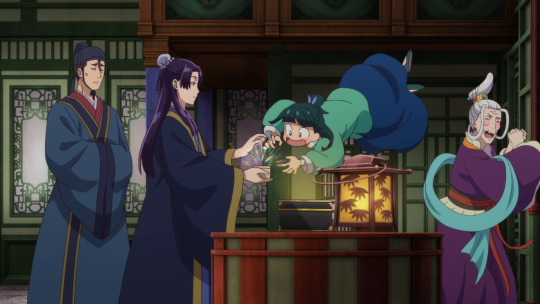
6. The Apothecary Diaries, second cour
I found myself more intrigued at The Apothecary Diaries at the end of 2023 than most other shows I’d watched that year. I grew more and more invested in the idiosyncratic Maomao as she investigated mysterious ailments and navigated imperial palace politics, all the while being a lovable little shit.
Before I’d realized it, though, the 2024 half of its run knew it had its hooks in me and took me for a ride. What looked at first like a series of one-off puzzles quickly began entangling into a much larger mystery, rapidly gaining momentum until exploding into a massive emotional payoff. So many of the small details in what you assume are episodic mystery-of-the-week mini-stories become relevant in unexpected ways and draw you in ever further. I adore this kind of lowkey long-term storytelling, and for it to be part of such an appealing package is basically catnip for me.
For as gorgeous as The Apothecary Diaries can be visually, sonically, and sometimes even emotionally, it’s worth mentioning that this show is also hilarious a lot of the time. Maomao is on permanent goblin mode whenever she isn’t carrying out official business, and any time the palace officials have to rein her in is a delight. The push-and-pull between her and Jinshi is endlessly entertaining to the point where I can wait forever for that payoff if I have to.
I neglected to read the Apothecary Diaries manga after the first season went off the air (though I nearly bought all of it sight unseen), and with the second about to drop, I guess I’m holding off for another six months. Can’t say I mind, though. I’m along for the ride and I want this show to keep surprising me for as long as it can. This is easily one of the best anime of the 2020s so far and I’m gonna be there front row center for every new episode.

5. Bang Brave Bang Bravern
People say “peak fiction” too goddamn often these days. Not that it was a meaningful term to begin with, but it’s been memed to hell and back and is mostly just thrown out ironically to mock garbage writing. To be honest, I’m not above it myself, but I prefer to ascribe it, even jokingly, to stuff that can only truly come from a brilliant and/or deranged mind. Preferably both. Peak fiction, to me, is the intersection where talent meets insanity, no matter the degree of either.
Bang Brave Bang Bravern is peak fiction.
I gushed about this show after the winter season, and I almost don’t want to say anything further about it, mostly for two reasons: Firstly, because I don’t really want to give the game away any more than I already did back in April, and secondly, because I think it may have permanently burrowed into a specific part of my brain and then melted it. All I’m left with is “this show fucking rocks, dudes rock, you need to see it, it’s peak, don't ask questions, just watch it.”
Indeed, Bravern is the Dudes Rock anime of the year, and an essential piece of Dudes Rock media. It’s Top Gun with aliens and a giant talking robot. And the robot wants to fuck his pilot. This show is loud, horny, stupid, and self-aware, combined just so into a cocktail of legitimate brilliance that is, for better or worse, unlike anything I’ve seen before or since. Nearly every single episode had me clawing at my hair and shrieking “WHAT THE FUCK AM I WATCHING,” and that is the highest praise I can give just about anything.
I might be overselling it just a touch, but Bravern is just as earnest as it is utterly wild. It’s an intentionally hilarious show, but it means everything it does and says. It’s a love letter to mecha anime and tokusatsu, and with its top staff sporting Gundam and Macross bona fides, that love oozes into every aspect. The mechs, both manmade and alien, all look tremendous, the music is a throwback to the goofy bombast you’d find in series like this as far back as the Showa era, and the ensemble cast outside of our silly leads are just as gung-ho and serious about Saving The World as you’d find in just about any other mech show. Anything that can be this goofy with a completely straight face is going to hook me in.
All in all, Bang Brave Bang Bravern is hypercompetent lunacy with heart. Call it weaponized genre awareness if you must, but it knows exactly what it’s about, grabs you by the collar, and takes you for a ride, all while doing badass tokusatsu poses and calling out special moves with silly names. This is legitimately what fiction is all about.
Also, if you don’t like Lulu just because she screeches a lot, you’re a weakling. Gaga-pi, motherfucker.

4. The Dangers in My Heart, season 2
This was a series whose first season was conspicuously absent from my 2023 rankings, but I caught up shortly after finishing that list in order to catch up to the second season. I’d watched a glut of slice-of-life romances in 2023 and figured I could afford to miss this one. I’m overjoyed at how wrong I was.
To paraphrase the second season’s exceptional OP, The Dangers in My Heart is indescribably beautiful. As I said with A Sign of Affection, I love me a straightforward anime romance, and this middle school slice-of-life is just that: Underdeveloped edgelord boy ends up making unlikely friends with, and falling for, the cheery popular girl in his class. This is easy wish-fulfillment on paper, but that’s hiding the trick: Kyotaro isn’t gonna get anything he wants by keeping his quills out for anyone who comes near, and he has some growing up to do if he’s ever gonna get what he wants.
Season 2 picks up right where the first left off, with Kyotaro’s arm still broken from his family trip and Anna feeling guilty because she thinks her distraction was what led to the injury. Right out of the gate, we see the care these two have developed for one another: Anna wants to help while he can’t do his own schoolwork, while Kyo is quick to try to cheer her up when she no longer feels like she’s able to. Already we’re seeing Kyotaro’s character development coming to light: The Dangers in My Heart isn’t a story about a Nice Guy getting the girl just by being there; it’s a story of self-improvement, of trying to become the type of person whom your crush would want to fall in love with. For a story about and ostensibly marketed to early teenagers, that’s a good lesson to have, and I absolutely devour stories like that.
As can be the case with plenty of adolescents, most of the conflict here is internal. Kyotaro spent the early part of his middle school education keeping a safe distance from everyone in order to avoid getting hurt, and as you can imagine, that did a number on his self esteem. Though he’s mostly kicked the chuunibyo mindset, Kyo still prefers to keep his distance, less because he doesn’t want to get hurt, but now because he doesn’t want to hurt anyone else. Specifically Anna. So much of this story is about him learning to be okay with letting people in and not just falling in love, but making friends and becoming somebody whom people just want to be around. It’s a chuuni rehabilitation story. You love to see it.
With all due respect to mangaka Norio Sakurai, the biggest surprise that came from reading the manga was how much better the anime looks than its source material. The anime looks tremendous in its own right, but compared to Sakurai’s doodly, occasionally messy style, the love put into the show stands in stark relief. Characters, backgrounds, and lighting are all soft, squishy, and warm, almost like the entire thing was run through the filter through which only a 13-year-old in love can see the world, even as a little edgelord. Little flourishes in the environment and music highlight the minute but consequential motes of progression in Kyo and Anna’s relationship. The OP ended up shaking out as my favorite of the year, even with 2024 being bookended by Creepy Nuts bangers. It’s that special to me.
And just like that, The Dangers in My Heart went from “eh probably not for me” to “yeah this is one of the best anime of the decade so far.” It’s a simple slice-of-life romance on paper, almost literally so in the manga, but this is a transformative adaptation. There’s much more of the story to tell, and I wouldn’t complain about more, but as it stands after two seasons, The Dangers in My Heart is damn near perfect as it is.
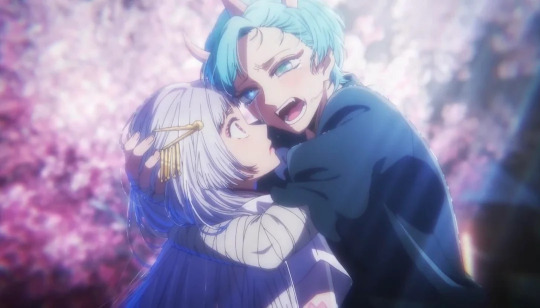
3. Oshi no Ko, season 2
Another year, another season, another top-four finish for one of the best manga adaptations I’ve ever seen.
The anime adaptation of Aka Akasaka and Mengo Yokoyari’s showbiz-revenge manga made shockwaves last year following its thunderous feature-length premiere, and its source material made even more waves due to some questionable plot developments that fortunately went nowhere. Doga Kobo was undeterred by any negative attention brought to the brand, though, and pressed forward into the next arc with a level of swagger you rarely see brought into an anime’s sequel season.
The 2.5D stage play arc in Oshi no Ko’s manga wasn’t my favorite, but it was one that you could tell just from reading it would translate well to the screen. Even then, I wasn’t prepared for just how hard Doga Kobo would go in adapting it. Character animation is sumptuously fluid, color used to amazing effect, and personal expression bursts forth into impressionistic abstraction to such a degree that it made manga artist Yokoyari cry. Everyone looks and sounds incredible beyond any way I could’ve imagined from reading the manga, which, at the risk of sounding defensive, is still very good as a whole.
This being a story largely about the music industry, the music remains as on-point as ever. It’s too soon to tell if the second season’s OP/ED pairing tops the instantly-iconic “Idol” and “Mephisto” from the first, but these are no slouches. This season’s OP, “Fatale,” is a whiplash-inducing banger by Tatsuya Kitani and idol Kento Nakajima, performing under the collaborative name of GEMN (itself a relevant name to the show; twins without the i/Ai, DO YOU GET IT???) with visuals that might actually top those of "Idol." The new ED, “Burning,” is Hitsujibungaku at their fuzzy, 90s-style alt-rock best, and it takes on a brand new meaning by the end of the season. Of course, there’s also the story-relevant music; while the bulk of the season focuses on the stage play, the last few episodes give us a glimpse into the pop music process, with the season capping off with an in-universe music video that, while not sonically my exact cup of tea, features 90 seconds of some of the best-looking dance animation I’ve ever seen in my life. That’s a flex if I’ve ever seen one.
And just like the first season, the second capped off with an announcement that Oshi no Ko will indeed be returning for another season. At this rate, and with the anime’s success, they will adapt the entire work, which will raise some eyebrows. I’m not going to litigate the manga’s later controversial developments nor its widely-panned ending, but if Doga Koba was able to handle everything that came before those things with such aplomb, I have faith that it will at least be done well.
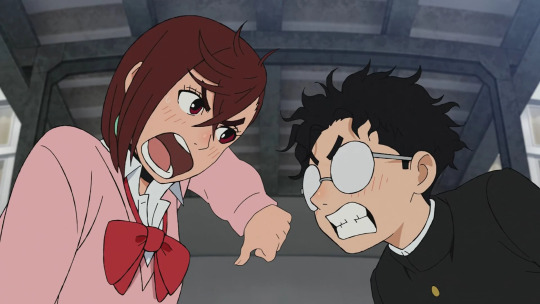
2. DanDaDan
I want to preface this by saying that I agonized over whether this or the final entry is my anime of the year. I’m comfortable with what I chose, but if I’m being realistic, DanDaDan is basically 1b. This is a masterpiece already.
Although the source material was a bit of a cult hit until this year, DanDaDan came with a considerable amount of hype. If you were even peripherally familiar, it wasn’t hard to see why: Yukinobu Tatsu’s art is absurdly detailed in almost every panel, character designs are easily recognizable (one of the leads dressing similarly to a Persona 3 character was fortuitous for the anime to drop in the same year as Reload), and so many bizarre things happen in the plot that relaying them to anybody who wasn’t already familiar would make their brain briefly touch the void. Above all, though, Science SARU was tabbed to animate it, and any project by them is immediately worth your attention.
Sure enough, DanDaDan made an instantaneous splash, its first episode adapting the manga’s bombastic, twisty 63-page opening chapter nearly beat for beat. I’m not gonna “don’t look it up, just go in blind” this one, but almost too much happens for me to properly detail it all without just writing a complete synopsis. It boils down to “lonely nerd boy believes in aliens, angry kogal believes in yokai, it turns out both are real and now they have to deal with it.” It’s silly, it’s wild, it’s action packed, and if you can stomach the sexually-compromising alien abduction of the girl, you’re along for the ride.
I’m not gonna harp too much on that last point. It does stink that the female lead, Momo, is stripped to her underwear for the sake of alien sexual “research,” but said aliens get their comeuppance before anything happens to her. It’s still not great, and it’s not the last time female characters are portrayed in their underwear, but I do promise it’s for story reasons, it takes a backseat to the onscreen action and is pretty clearly not done for the sake of fanservice. I know such things can be beyond the pale for some people, but if you think you can compartmentalize that, I recommend you watch the first episode with that caveat in mind and decide from there. You may be pleasantly surprised.
DanDaDan is effectively two stories at once; on one side, we have Momo and the boy, Okarun (a nickname Momo devised for him to preserve her own sanity), gaining wacky supernatural powers in order to fight back these occult threats and regain what was stolen from Okarun from his first encounter with the unexpected (IYKYK). Because these threats can come out of nowhere, their daily high school lives can completely pop off without warning. On the other side, we have quieter slice-of-life tension as Momo and Okarun get to know (and frequently misunderstand) each other and realize they are completely and hopelessly head-over-heels for one another.
Surprise, motherfucker: DanDaDan is a romcom.
Yukinobu Tatsu, formerly an assistant on the first saga of Chainsaw Man, long struggled to get his own work serialized. At his editor’s urging, he read something like a hundred manga for inspiration, including several shoujo romance series. That research shows through in DanDaDan; although the bonkers action sequences and off-the-wall monster designs are what draw in readers and viewers alike, what’s kept this many people along for the ride is the beating heart just barely under the surface in the form of the romantic tension between Momo and Okarun. It’s easy to write this off as some “lonely nerd gets the cute gyaru just by being a Nice Guy” wish fulfillment, but that’s not really the case here; Okarun was a weird little twerp right from the jump. Similarly to Kyotaro in the aforementioned Dangers in My Heart, Okarun believes early on that he’s nowhere near Momo’s league, completely unaware that she quickly grows to actually like having him around, so he puts in the effort to become a more well-rounded person so that he can be confident enough to be seen next to her. He also just wants Momo to think he’s cool, and she thinks that’s adorable. And she’s right! These two are cute as fuck together.
So you come for the wild action and stay for the tremendous character dynamics. It should go without saying that Science SARU nailed all of the above, but I’m gonna say it anyway. Reading the Manga+ comments on each chapter as I read through the manga, readers were begging a top-flight battle shonen studio like MAPPA or WIT to pick up the series, and I think these fans got more than they bargained for. Masaaki Yuasa hasn’t been in charge of a series at the studio since Eizouken, or anything they’ve put out since Inu-Oh, but his influence is all over their recent works, including last year’s fellow top-three series, Scott Pilgrim Takes Off. It’s beyond impressive how, much like Scott Pilgrim, this series manages to maintain the source material’s art style while still looking very much like a Science SARU anime. Everyone is bouncy and malleable as their moods dictate, line weights are wildly varied, and action animation is kinetic and unpredictable. Each fight with an alien or cryptid is awash in eye-searing color or eerie greyscale. The music is a boatload of fun as well; even putting aside the Creepy Nuts OP (banger after banger after banger from those dudes) and Zutomayo ED, regular proceedings are punctuated by a wildly varied score, from funk to folk to an insane chase scene set to an electronic mashup of the “William Tell Overture” and the can-can. Everything about DanDaDan keeps you guessing.
I was looking forward to DanDaDan enough that I went to the theatrical premiere of the first three episodes and was sufficiently blown away. If you’ve seen the show, it shouldn’t come as much of a surprise that it looks and sounds incredible in a cinema setting. I left the theater positively buzzing, telling anyone who’d listen that they had no idea what was coming, but even knowing the entire story, I wasn’t prepared for more of what was to come. The literal next episode after what I’d already seen in the theater had one of the most bonkers action setpieces I’ve seen since Gurren Lagann, and just three episodes later an unbelievable emotional gut punch, prior knowledge of the manga be damned. Every single aspect of DanDaDan as an anime was given the same level of love and care that Tatsu put into his own work. It’s one thing for an anime adaptation to be faithful to its source material, and another entirely for it to elevate and transform it. DanDaDan somehow does both.
If there’s anything that held this back from being the anime of the year, it’s that this season kind of just… ends. With the 12-episode runtime that was given to the debut season, DanDaDan ends its first run right after the beginning of the manga’s next arc, which feels bizarre. There’s no resolution, but there’s no real cliffhanger here either. Which I kind of get, the story is driven by a constant forward momentum, but a little warning that the season was ending would’ve been nice. It’s only a six month break until the show comes back, but judged on its own, the way this season ended left me feeling a bit cold and the season itself feeling incomplete. Even shows that have year-long breaks between cours rather than seasons tend to put some kind of cap on each individual run, but DanDaDan just kinda left the toilet unflushed, and next to it a Post-It note promising to come back later. For something this lovingly crafted, that seems like a bizarre oversight.
That was hardly enough to temper my enjoyment though. Anything this well-made is deserving of the attention and success it’s attained, but to have this story, with these characters and this level of bonkers action made this well, is just an embarrassment of riches. And God help me, I’m shamelessly greedy. July can’t come fast enough. I need all of it.

1. Delicious in Dungeon
At the end of its run midway through the year, I declared Dungeon Meshi the best anime of the year up to that point and that I’d be impressed if anything would manage to overtake it. Though the other two entries in my top three made extremely strong cases, nothing else hit the spot and nourished the soul quite like Dungeon Meshi.
Barely a year removed from one of 2022’s best anime, Cyberpunk Edgerunners, Studio Trigger kicked off 2024 with another Netflix original, this time with its first proper manga adaptation since the studio split from Gainax a decade prior. It seemed an odd fit at first to have a studio known for wacky, hyperkinetic action productions like Kill la Kill and Promare to adapt this quirky fantasy dungeon manga, but hey, they also did Little Witch Academia. It turned out to be an odd fit, but in the best way: Dungeon Meshi is pretty offbeat as it is, so for it to get picked up by one of the more oddball prestige studios ended up making a tasty stew.
I struggled to elaborate on what makes this show so good after each of its cours, and six months later I remain a little lost for words. It’s an exceptional story adapted exceptionally well. Between the characters, the story, the setting, the emotional stakes, the comedy, the highs and lows, they nailed it all. Trigger just gets it. Even when characters go off-model for the sake of an intentional animation quirk, it still has that inimitable Trigger charm to it. It sounds just as good as it looks, too: The orchestral score highlights the quieter, sillier moments just as well as the tenser action setpieces, the foley work behind the dungeon’s bizarre and varied flora and fauna is immaculate, and the cast is perfect in both Japanese and English (I rarely ever say so but seriously, shout out to the dub).
I’m just as sick of saying “this show speaks for itself” when I have trouble finding the words as you probably are of reading it, but I have little else to add here. I’ve written plenty already. Just go watch it. This is already one of my favorite manga ever, and by the time the series wraps up at the end of its second season, it will easily end up as one of my favorite anime ever.
#anime reviews#blue box#girls band cry#frieren#a sign of affection#the apothecary diaries#bang brave bang bravern#the dangers in my heart#oshi no ko#dandadan#dungeon meshi
113 notes
·
View notes
Text
Commercial Underwriter (Fully Remote or Hybrid-Working) - Exeter
Job title: Commercial Underwriter (Fully Remote or Hybrid-Working) – Exeter Company: Aston Charles Job description: enquiries from a wide variety of brokers throughout the UK, using your sound technical and negotiation skills to secure…, collaborating with the Claims team, as well as developing and maintaining excellent working relationships with the Technical… Expected salary: Location:…
#agritech#Android#artificial intelligence#audio-dsp#Azure#cloud-computing#cloud-native#CRM#data-privacy#data-science#DevOps#fintech#full-stack#generative AI#GIS#iOS#legaltech#Machine learning#metaverse#mlops#no-code#power-platform#product-management#remote-jobs#sharepoint#site-reliability#Technical Writer#telecoms#vr-ar
0 notes
Text
Generative AI: Unveiling New Telco Centric Potential

The Generative AI Frontier in Telecom: Challenges and Transformations
The advent of generative artificial intelligence (AI) in telecommunications presents a unique set of challenges, distinguishing it from traditional tech hurdles. While it promises unparalleled innovation, the integration of generative AI confronts telecom providers with issues of adaptability, complexity in deployment, and the creation of truly personalized customer experiences. These challenges are not just technical but also strategic, as they necessitate a reimagining of service delivery models to fully leverage AI's potential.
Redefining Telecommunications with Gen AI Innovation
In this transformative era, generative AI emerges not just as a technological advancement but as a strategic asset redefining the telecom landscape. By embracing these challenges as opportunities, generative AI paves the way for groundbreaking solutions in personalization, efficiency, and scalability. It enables the creation of dynamic, AI-driven interactions and services that anticipate and adapt to customer needs in real-time, offering a level of customization previously unattainable. This AI-driven shift revolutionizes telecom, transforming challenges into opportunities for unmatched customer satisfaction and operational success.
Advancing Telecom: The Rise of Gen AI Innovations
The landscape of telecommunications is being radically transformed by the latest advancements in generative AI, introducing a future where efficiency, personalization, and innovation converge to create unparalleled customer experiences. These cutting-edge features are not just enhancements; they are the cornerstone of a new digital telecom era, designed to astonish and exceed expectations.
AI-Driven Marketing Campaigns: Revolutionizing outreach by creating deeply personalized, AI-generated content that dynamically aligns with individual customer profiles and preferences, setting a new standard for customer engagement.
Next Best Reward Optimization: Employing predictive analytics to customize loyalty incentives in real-time, fostering an unprecedented level of customer loyalty and satisfaction and boosting the NPS.
Enhanced Customer Connections: Through Generative AI, telecom services tap into extensive data to customize each interaction, ensuring every customer feels uniquely valued. This approach fundamentally alters customer perceptions, fostering a deeper relationship with their service provider
Proactive AI Notifications: Anticipating customer needs and delivering timely, relevant information through intelligent automation, enhancing the customer journey with every interaction.
Intelligent Case Management: Streamlining support with AI-driven insights and recommendations, significantly reducing resolution times, first contact resolution while simultaneously elevating the quality of customer service.
To Know more visit: Covalensedigital
Visit: Covalensedigital LinkedIn
Follow Us on: Covalensedigital Twitter
0 notes
Text


𝐉𝐄𝐑𝐄𝐌𝐘 𝐊𝐈𝐍𝐆
Birthdate: April 26, 1997 Family (siblings): Jamie, Julien, and Reina King Hometown: London, England Current location: London, England
Background: For generations, the King family has been one of the wealthiest, more astute British families. The family made their start with a printing press in the 1800s. It went from newspapers, then media, telecom, and finally, luxury hotels around the world. Many of the family members from generation to generation have chosen to remain heavily involved in each of their various businesses, either serving on the board, or acting as CEOs. Currently, Jeremy is serving on the board for their media company, and shadowing his sister, Reina King-Chambers, who is currently the CEO. Reina believes Jeremy should be the one to take over in the next year or so, as she wants to step down to spend more time with her young children. Jeremy has been anything but accepting of this chosen fate. He wants to travel the world — to surf, ski, and hike. To be free of responsibilities. But, to his core — to almost every King’s core — is a duty-bound heart tied to their family.
40 notes
·
View notes